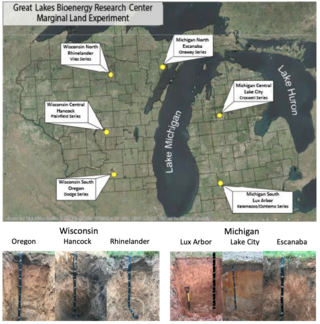Soils of the GLBRC Marginal Land Expeirment (MLE) Sites
C.S. Kasmerchak and R. Schaetzl "Soils of the GLBRC Marginal Land Experiment (MLE) Sites" KBS LTER Special Publication (2018) [DOI: 10.5281/zenodo.2578238]
The Great Lakes Bioenergy Research Center (GLBRC) Marginal Land Experiment (MLE) was established in 2013 at various sites in Wisconsin and Michigan to evaluate the potential use of low productivity or abandoned agricultural fields for low input bioenergy feedstocks. Three sites in Michigan and three sites in Wisconsin were initially established and are distributed in the southern, central and northern part of each state (see front cover). In 2018 the Wisconsin South site (Oregon, WI) was retired from the MLE due to high fertility soils. Six different biofuel cropping systems from the GLBRC Biofuel Cropping Systems Experiment (https://lter.kbs.msu.edu/research/long-term-experiments/glbrc-intensive…) are replicated in each of 4 blocks at each site. The systems include switchgrass (Panicum virgatum variety Cave-inrock), miscanthus (G6, Miscanthus x giganteus), native Grasses (G7, a 5-species mix), hybrid poplar (G8, “NM-6”, Populus nigra x populous maximowiczii), early successional vegetation (G9), and restored prairie (G10, 18-species mix including forbs, grasses and legumes). There is also an historical vegetation (G11, unplanted) reference treatment.
The publication and associated dataset can be found on Zenodo.
